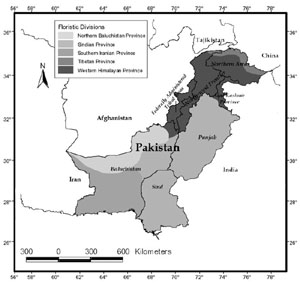 |
QUICK SEARCH
MO PROJECTS:
Africa
Asia/Pacific
Mesoamerica
North America
South America
General Taxonomy
Photo Essays
Training in Latin
America
MO RESEARCH:
Wm. L. Brown Center
Bryology
GIS
Graduate Studies
Research Experiences
for Undergraduates
Imaging Lab
Library
MBG Press
Publications
Climate Change
Catalog Fossil Plants
MO DATABASES:
W³MOST
Image Index
Rare Books
Angiosperm
Phylogeny
Res Botanica
All Databases
INFORMATION:
What's New?
People at MO
Visitor's Guide
Herbarium
Jobs & Fellowships
Symposium
Research Links
Site Map
Search
Inventory of the Plants of Pakistan
INTRODUCTION
Figure 1. Map of Pakistan, showing boundaries of the four provinces (Baluchistan, Sind, Punjab, and North-West Frontier), one territory (Federally Administered Tribal Areas), and the Pakistani-administered portion of the disputed Jammu and Kashmir region (Azad Kashmir and Northern Areas). Shading indicates floristic provinces as delineated by Takhtajan (1986). The underlying basis of this disjunction has been explored by numerous biogeographical analyses, such as those of Stewart (1972), Zohary (1973), Ali (1978), and Hedge & Wendelbo (1978). Takhtajan (1986), summarizing much of this literature, delineated five distinct floristic provinces that extend into the territory of Pakistan (Fig. 1). Two of these provinces, the Southern Iranian and Sindian Provinces, belong to the Sudano-Zambezian Region (African Subkingdom, Paleotropical Kingdom), which extends west along the southern Arabian Peninsula through the Horn of Africa to eastern tropical Africa and across to the Atlantic coast of Mauritania, Senegal, and Guinea. The other three floristic provinces in Pakistan belong to the Irano-Turanian Region (Tethyan Subkingdom, Holoarctic Kingdom): the Northern Baluchistan and Western Himalayan Provinces in the Western Asiatic Subregion, and the Tibetan Province to the Central Asiatic Subregion. Thus, the source and affinities of the plants of southern and southwestern Pakistan are with central and eastern Africa and the coastal regions along the Arabian Sea, whereas the source and affinities of the flora in northern Pakistan are with Central Asia, from Turkey in the west to the Gobi Desert in the east. In addition, eastern Pakistan has an admixture of elements from the Indomalesian Subkingdom (Paleotropical Kingdom), and in the monsoonal forests in Azad Kashmir, one finds elements of the Eastern Himalayan Province (Eastern Asiatic Region, Boreal Subkingdom, Holarctic Kingdom).
The flora of Pakistan includes no endemic families, and only three endemic genera (Douepia in Brassicaceae, Stewartiella in Apiaceae, and Decalepidanthus in Boraginaceae). In all, there are some 203 endemic species, or about 4% of the flora (Ali 1978). Many of these endemic species are found in the montane regions of northern Pakistan, particularly in the Chitral and Kashmir districts, and in northern Baluchistan. Notwithstanding, these regions are considered to be relatively poorly known and likely to be sources of new species (Chaudhri 1977, Frodin 1984).
In order to begin to address these problems, Pakistan needs good information about its natural resources. A Flora based on all available plant collections and on the most current taxonomy and phylogeny of those plants is an essential first step to understanding, managing, and preserving the biodiversity of any area. Because terrestrial communities are generally defined by their plants, a Flora forms the foundation to which inventories of animals, fungi, etc., can be added. Completion of the Flora of Pakistan will provide scientists and government officials with critical information for management of their resources. Because the database resulting from this project will be geographical in nature, it can be used with data on soil types, precipitation, and other parameters to address questions such as what intact habitats should have highest priority for conservation, and what types of plants should be used in restorations for erosion control, reforestation, and the like.
Nasir (1991) conservatively estimated that 580-650 plant species (c. 12% of the flora) are threatened or endangered, but suggested that this number would increase when work on the Flora is completed. He cited habitat destruction, over-exploitation of economic plants, introduction of alien species, and pollution as the major causes for this threat. Nasir (1991), Sulaiman et al. (1991), and others suggest that awareness of the problems is widespread, but that additional knowledge and information is critical if the problems are to be addressed and solutions found.
Many results of the proposed project will have a direct and beneficial impact on conservation efforts in Pakistan. Knowing what species occur where, at what elevations, with what other species, and whether the species is rare, is the type of information that is critical for informing decisions about where to establish conservation areas, how big to make them, etc. The ability to combine data on known collections, soil types, elevations, associated plants, and other parameters will make it possible to identify areas of potential distribution of rare species, or to select appropriate plants to be used in ecological restorations. In a country with limited resources suffering serious problems of deforestation, soil erosion, and desertification (Nasir 1991), the ability to make rapid, fully informed decisions regarding restoration and other conservation projects is extremely important, and depends on sufficient background data.
|
© 1995-2025 Missouri Botanical Garden, All Rights Reserved
4344 Shaw Blvd.
St. Louis, MO 63110
(314) 577-5100
Technical Support
